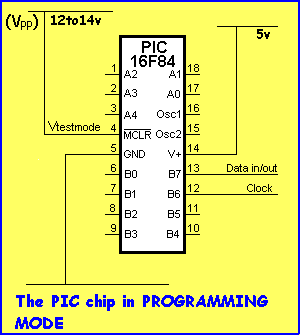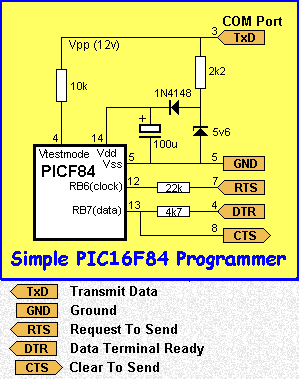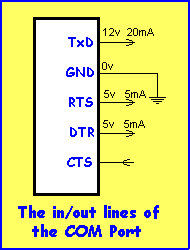5x7 Display
Burning
a Chip
Page1
PRELIMINARY
THINGS THE BASICS The four requirements above (12 to 14v, 5v for the
chip, Clock and Data) can be obtained from the serial port of a
computer as shown in the diagram below:
To understand the 5 lines of the COMmunications Port,
the direction of data flow and the voltage on the lines, we have to go back
to the basic details of a SERIAL COMMUNICATIONS PORT. Once we know the features of the lines, we can write
software to make them HIGH or LOW and either deliver data or receive data. More to come.
![]()
AND
BACKGROUND NOTES
To go to actual "BURNING A CHIP" -
CLICK
HERE
This section shows how to connect
a PIC chip to a COM port
Burning a chip is also called Programming
but since we refer to writing a program as "programming," we can
think of burning a chip as "DOWNLOADING, DUMPING or BURNING."
The microcontroller we are using in this project (PIC16F84) can be
programmed and re-programmed up to 1,000 times and this makes it ideal for
experimenting.
The other advantage of this chip is the ability to program it while it is
"IN CIRCUIT." The manufacturer of the chip
has produced only very vague information on how to design a project capable
of self-programming the chip when it is fitted to a project as they have a vested interest in
selling their own "simple programmer".
But we want to do it even cheaper than the cost of a commercial programmer and we want
to design with almost NO EXTRA parts on the
board to provide this function.
And it is quite possible. There has been a range of programmers capable
of doing this, from a NO PARTS programmer to those having buffer chips to
improve the programming signals.
At first glance these programmers may seem to be ideal but after studying
and trying each
of them; the complexities they contain, don't make them suitable for the
beginner. In simple terms, they were too difficult to get going. The authors
were highly technical people and they expect highly technical
constructors to put them together.
They offered little or no technical back-up and some don't even supply a
circuit diagram! It would have been nice to take one of these "Public
Domain" projects and use it in our project. But they weren't suitable.
Many of them did not verify the contents of the chip after programming and
others were not suitable for programming a chip "in-situ." You had
to take the chip out of the project and program it on a separate board. Some
needed a 5v and 12-14v rail, while others needed to run under DOS. After eliminating each design, we
ended up with having to design something ourselves. So here it is.
The basics of programming a PICF84 is simple. When /MCLR (pin
4) is taken HIGH (to a voltage called VIHH
12v to 14v), the chip turns into programming mode and two pins change from
in/out pins to Clock and Data pins.
Port B bit 6 (pin 12) changes from an in/out pin to CLOCK. (to
clock data into the chip during programming and clock it out of the chip
during "read" mode)
Port B bit 7 (pin 13) changes from an in/out pin to DATA in/out.
The /MCLR pin becomes Vtestmode during programming mode.
Data books on the PIC16F84 state that the programming voltage (about 13v) is internally
generated and the voltage delivered to the Vtestmode pin is purely a
reference voltage and no current is required to be delivered to this pin
during programming.
Using these features we can produce a circuit with the PIC chip in
programming mode. This is shown in the diagram below. This is not a
functional circuit as the programming voltage (Vpp) must be able to be
switched from LOW to HIGH to place the chip in programming mode.


The original use for this port was to connect a computer (called the Data
Terminal Equipment - DTE) to a device such as a printer, plotter or modem
(called the Data Communications Equipment - DCE). The mode of communication
is called RS-232. None of this involves our use of the port as we are not
using it in the way it was intended. For instance, we are taking advantage
of the fact that one of the lines produces a voltage of 12v and we use this
voltage to power the project during programming.
To understand how the lines can be used, you need to know if each line is an
input or output and the voltage it is capable of supplying. Some of the
lines are capable of supplying very little current (less than 1mA while
others can supply 25mA to 35mA). Since our project draws very little
current, (only 1mA or so in programming mode) the current capability of the
lines is not an issue. But the voltage they are able to produce and the
direction of signal-flow, are the issues.
The diagram below shows the features of the 5 lines.

The TxD line is the Transmit Data line and it is purely used for the 12v it
is capable of supplying. IT is taken HIGH during programming so supply both the programming trigger
voltage for pin 4 of the PIC as well as the 5v rail for the operation of the
chip.
RTS is an output line from the computer and it will be used to clock the chip during programming mode so that command bits
and data
bits (from the DTR line) can be delivered to the chip.
To put the PIC chip into programming mode, RTS and DTR are held LOW and TxD
is taken HIGH. The chip now waits for 6 bits of data called a COMMAND. The
first command may be "Load Configuration" or "Load Data for
Program Memory" or "Bulk Erase Program Memory." In this way
the commands and the data is placed in the PIC.
After programming is complete, the program can be READ by sending a command
"Read Data From Data Memory" and the bits will be transmitted out
of the PIC to the computer via the CTS line.
Resistors are needed between some of the lines and the chip to limit the
current.
The 10k in the diagram above is not really needed but since Vtestmode pin
requires very little current, the 10k will not upset the voltage delivered
to the chip.
The 2k2 feeding the 5v6 zener allows the 5v6 to be generated without
reducing the voltage on the TXD line.
The 22k on the RTS line allows almost any voltage to be present on the RTS
line and only deliver a maximum of 5v to the PIC.
The 4k7 serves two purposes. It limits the voltage from the DTR line to 5v,
and allows the PIC to deliver an output to the CTS line. In other words, if
the DTR line is LOW, the PIC will be able to deliver a HIGH to CTS.
Go to the next page:
Burning A Chip - Page 2
![]()